So What's a Tessellator?
This has been covered before now in other articles about DirectX 11, but we first touched on the subject with the R600 launch. Both R6xx and R7xx hardware have tessellators, but since these are proprietary implementations, they won't be directly compatible with DirectX 11 which uses a much more sophisticated setup. While neither AMD nor the DX11 tessellator itself are programmable, DX11 includes programmable input to and output from the tesselator (TS) through two additional pipeline stages called the Hull Shader (HS) and the Domain Shader (DS).
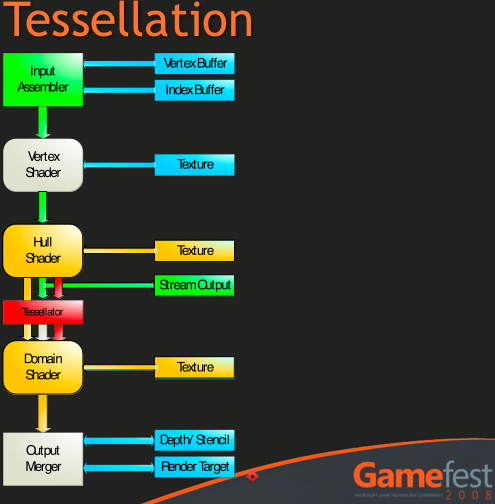
The tessellator can take coarse shapes and break them up into smaller parts. It can also take these smaller parts and reshape them to form geometry that is much more complex and that more closely approximates reality. It can take a cube and turn it into a sphere with very little overhead and much fewer space requirements. Quality, performance and manageability benefit.
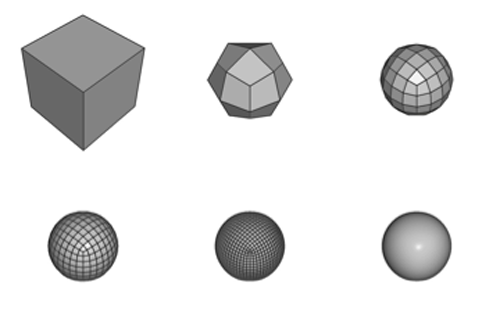
The Hull Shader takes in patches and control points out outputs data on how to configure the tessellator. Patches are a new primitive (like vertices and pixels) that define a segment of a plane to be tessellated. Control points are used to define the parametric shape of the desired surface (like a curve or something). If you've ever used the pen tool in Photoshop, then you know what control points are: these just apply to surfaces (patches) instead of lines. The Hull Shader uses the control points to determine how to set up the tessellator and then passes them forward to the Domain Shader.
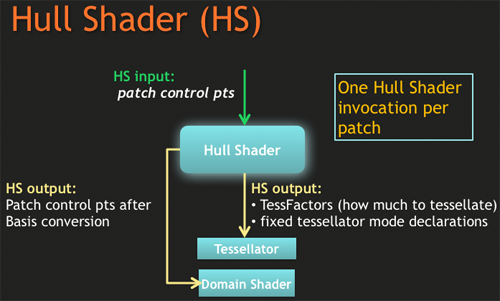
The tessellator just tessellates: it breaks up patches fed to it by the Hull Shader based on the parameters set by the Hull shader per patch. It outputs a stream of points to the Domain Shader, which then needs to finish up the process. While programmers must write HS programs for their code, there isn't any programming required for the TS. It's just a fixed function block that processes input based on parameters.
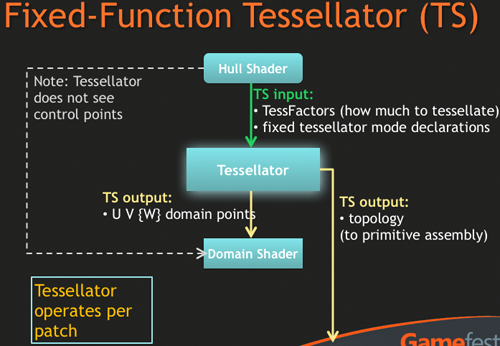
The Domain Shader takes points generated by the tessellator and manipulates them to form the appropriate geometry based on control points and/or displacement maps. It performs this manipulation by running developer designed DS programs which can manipulate how the newly generated points are further shifted or displaced based on control points and textures. The Domain Shader, after processing a point, outputs a vertex. These vertices can be further processed by a Geometry Shader, which can also feed them back up to the Vertex Shader using stream out functionality. More likely than heading back up for a second pass, we will probably see most output of the Domain Shader head straight on to rasterization so that its geometry can be broken down into screen space fragments for Pixel Shader processing.
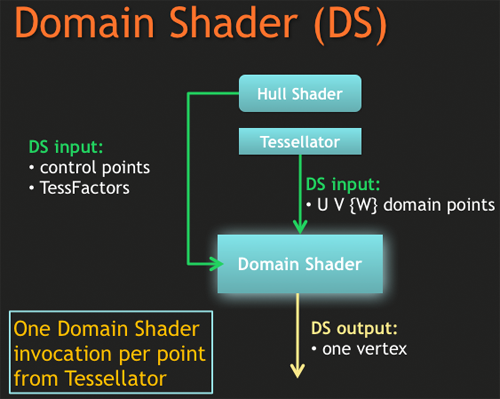
That covers what the basics of what the tesselator can do and how it does it. But do you find your self wondering: "self, can't the Geometry Shader just be used to create tessellated surfaces and move the resulting vertices around?" Well, you would be right. That is technically possible, but not practical at this point. Let's dive into that a bit more.










109 Comments
View All Comments
bobjones32 - Saturday, January 31, 2009 - link
Derek, Vista has been out for only 2 years. Take a look at XP's first two years and it was a phenomenal disaster comparatively. How people forget its far more significant performance and driver compatibility issues, and of course the Blaster worm, is totally beyond me.Just look at some of the nightmares: http://community.winsupersite.com/blogs/paul/archi...">http://community.winsupersite.com/blogs...8/06/30/...
Business uptake? Initial consumer uptake? Driver support? Gaming speed? Security? Compatibility? Vista's first two years have been incredibly successful compared to XP's first two years.
The difference? In 2001, sensationalist blogging making mountains out of molehills and purporting endless false perceptions without significant evidence wasn't nearly as popular. Apple's ads that only fed into peoples' ignorance only helped that false perception grow.
Zoomer - Monday, February 2, 2009 - link
Compare XP to 98SE.Now compare Vista to XP.
We have to take things in context.
CvP - Saturday, January 31, 2009 - link
TOTALLY AGREE.well said.
Goty - Saturday, January 31, 2009 - link
So the gist of this comment (Derek's) is that Vista doesn't suck, but you still say, "Vista sucks."I'm confused now.
Anyhow, I personally agree with the other people in the section that say Vista is a great operating system. I installed it in January of '07 and the only change I've made is to move from Business to Ultimate (thanks to the fact that I was using an ATI video card at the time and the fact that they didn't slack off on their driver development).
DerekWilson - Saturday, January 31, 2009 - link
Actually, that's an apt statement.Vista is currently something it was not initially. This made it "suck" in the hearts and minds of many people at the start, damaging the Windows brand and frustrating users. While, as I said, those issues are largely gone post SP1. This impacted Microsoft's ability to inspire confidence in the industry that everyone would eventually move to a platform that ran DX10, whether or not the OS eventually got to a stable place.
In spite of this, I use Vista: I have 6GB of RAM and I'm interested in DX10 for the sake of DX10 personally. I'm a bit of a technologist and I like things for the sake of the thing, really, but that doesn't mean that MS didn't drop the ball in their delivery of Vista.
just4U - Wednesday, February 4, 2009 - link
What made it suck in the hearts and minds of many people was the refusal to move away from what they allready knew. Changing your operating system has always brought alot of grumbling from the majority... but it's even more overstated with XP which has been around and in wide use far longer then previous Microsoft Operating systems.The beta form of Vista I found to be buggy as hell.. But ofcourse I was testing it on a 1800+ Tbird with 1G of ram. Later when I adopted it (before sp1) it was fine with very few problems. I'd even go as far as saying way way less then what XP had at launch.
CvP - Saturday, January 31, 2009 - link
and XP was much better *when* it was released?!until XPsp1, it was a piece of shit.
until XPsp2, it wasn't worth switching to XPsp2.
and all those lack of driver etc..it was not MS's fault.
poohbear - Saturday, January 31, 2009 - link
"calling it like it is"? i have vista64 premium and i much prefer it to win XP. I have the hardware to run it flawlessly ofcourse, and in that context it's anything but "sucks". would never go back to XP, so please vista has come a looooooong way and doesnt need superfluos opinions like this in 2009.mechBgon - Saturday, January 31, 2009 - link
Derek, if you take a look at Valve's monthly user survey, the ratio of Vista to WinXP users is now at about 1 to 2.1 and climbing by the month. That's not what I'd call "rejection of Vista." I think you've been reading The Inq too much :)As for your remark about Vista being a "WinME," I disagree. WinXP was the WinME of this era; it was basically Win2000 with a few bonus features, like WinME was a makeover of Win98SE. Once WinXP SP2 was released, *then* WinXP actually had some real merit over Win2000 in the security department, but that was late in the game.
Vista, however, is a paradigm shift, a watershed in Windows history. Stuff is not run at Admin level by default anymore, and never will be again. Pulling that off without breaking 80% of the existing software in the world was an amazing accomplishment that involved virtualizing the Registry and file system (a little-known facet of UAC, as it happens).
This is another misguided factoid:
"MS recognized that they had a problem and implemented and extended again and again downgrade options to Windows XP for customers who were unsatisfied with Vista."
Well heck, OEM Windows XP Pro comes with downgrade rights to run Win98 or WinME. It's not a backpedalling measure, nor a confession that WinME is better than WinXP. That's normal Microsoft policy so customers can license the current OS but use the previous version, temporarily or permanently, for whatever reason.
There will be downgrade rights with the appropriate versions of Windows 7, too.
suryad - Thursday, February 5, 2009 - link
I am not so sure you can just take Valve's survey which is just predominantly consisting of gamers as a good statistic. Thats just my 2 cents. An OS is not just meant for gaming...sure thats a good amount of Vista users in the survey but what about the rest of the people who are not gamers? I am pretty confident that most people who are on Vista and are on the Steam survey are/were sold by the appeal of DX 10 and next generation gaming and graphics and all that.